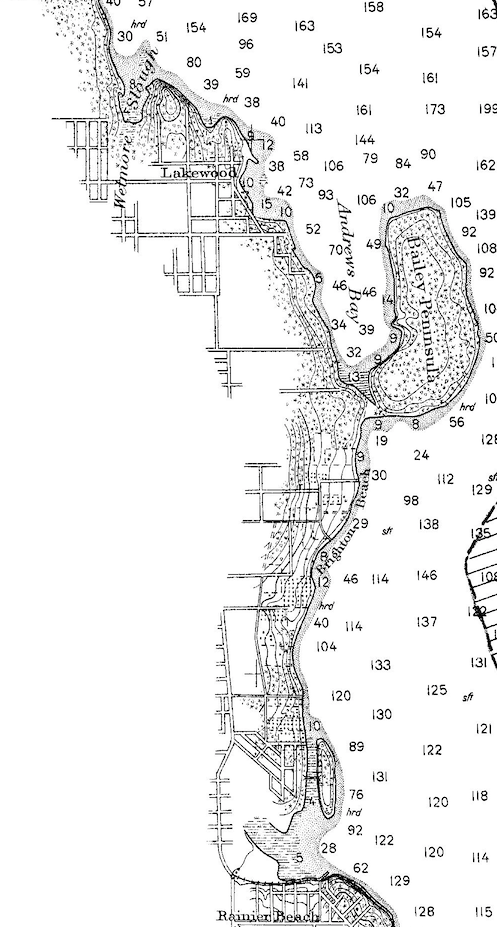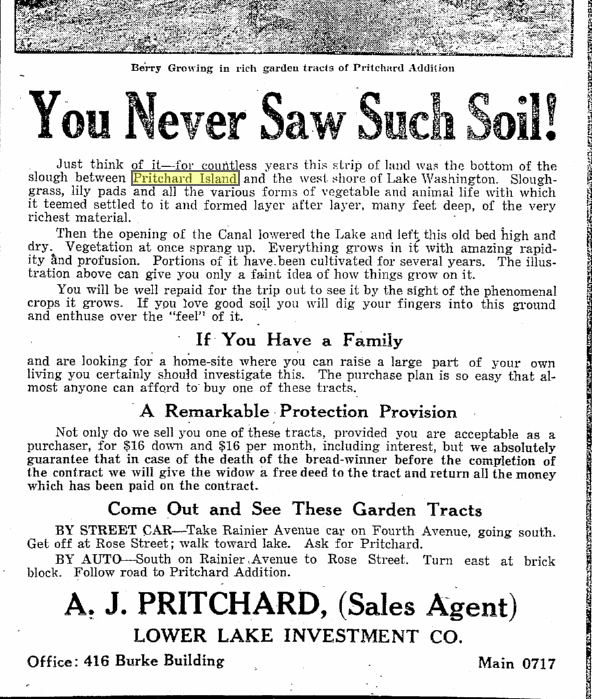The best map showing Lake Washington before the locks and ship canal lowered the lake in 1916 is one produced by the Coast and Geodetic Survey in 1905. Based on survey work done between 1856 and 1905, it shows the topography of the lake shore and the bathymetry. Today, I’d like to focus on one section of the map, which shows the area from Rainier Beach to Wetmore Slough (today’s Genesee Park).

In 1870, Joseph Dunlop homesteaded 120 acres along the water at Rainier Beach. Much of it was a swamp, or slough, an excellent place, according to one time resident, A. B. Matthiesen, to lie on a beaver dam and shoot ducks. Rainier Beach High School and its playing fields now cover the lowland. The adjacent Beer Sheva Park, originally Atlantic City Park, was also underwater, and the property east of it, an island, known as Youngs’ Island until Englishman Alfred J. Pritchard bought it in 1900. You can see on the map that a footbridge leads over the slough to reach Pritchards’ eponymous isle and estate, though the island is not labeled.
When the lake dropped and the former slough became dry, or at least mostly dry land, Pritchard, like others around the lake, sought to exploit the change. He took out large advertisements in the Seattle Times with the headline “You Never Saw Such Soil!” “Everything grows in it with amazing rapidity and profusion,” touted the ads. All it took was $16 down with $16 per month payments, plus interest.

The next noticeable feature north of the island is the Bailey Peninsula, or what we now call Seward Park. The peninsula connected to the main land by a flat wisp of terrain. Harold Smith, who had grown up in the neighborhood in the late 1800s, told a Seattle Times writer in the 1950s that during high water, the peninsula would become an island and the “isthmus could be crossed in a canoe or rowboat.” I doubt that many would call the modern connection to the peninsula an isthmus; it is now wide enough to look like a shoulder, a result of lowering Lake Washington by nine feet.
In 1912, when the Olmsted Brothers were working on their plans for the Seattle park’s system, some locals agitated for a canal through the isthmus so that tour boats could pass through. The steamers would be a boon to “poor people [who] had no means of getting to Bailey Peninsula…without walking a great way,” noted Dawson in a report to the parks on April 5, 1912.
Almost two miles north of Seward Park at Stan Sayres Memorial Park, is another landscape changed by the lower lake level. Labeled as Wetmore Slough on the map, it extended south almost to Rainier Avenue. If you wanted to cross over the slough at the lake, you went on a wood trestle bridge at what is now Genesee Street. The slough drained and for the most part disappeared after 1916 but local residents still complained that it was a source of noxious odors and an incubator for mosquitoes. To combat these problems, the Rainier District Real Estate Association proposed in 1928 to dredge a 200-foot-wide, 2,000-foot-long canal up the old slough, and to make Columbia City into a “seaport town.” Few cottoned on to the dream, though it persisted until 1937 when construction crews began to replace the old trestle with fill excavated from the lake. Six years later the city decided to convert the area to yet another “sanitary fill,” which generated a new round of complaints, this time about dog-sized rats and odors more redolent that ever.
Material for for this story comes out of research I have done for my new book on Seattle – Too High and Too Steep: Reshaping Seattle’s Topography.
If you so desire, you can like my geologywriter Facebook page.